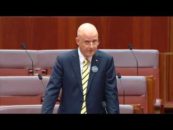When the new Reserve Bank governor Philip Lowe testified before a parliamentary committee recently, some Labor politicians who love big spending saw an opportunity. They quizzed him on the global failure of low interest rates to boost “aggregate demand” – the sum of all spending in an economy – and raised the case for more government spending to boost it. The new governor, keen to be polite and appear impartial, fell for the trap. While he rejected the relevance of the question for Australia, he went on to muse about global conditions and the general case for government spending on infrastructure.
That was enough for commentators of the left to declare that the new Reserve Bank governor supports more, smarter government spending. Infrastructure is it, they reported him saying, and conveniently left out any reservations about Australia.
In fact, the rest of the governor’s testimony was actually a defence of supply-side economics that would have made Reagan and Thatcher proud. Because while the Reserve Bank governor is responsible for managing “aggregate demand” through adjusting interest rates, he is acutely aware that this is not the sole, or even the key, driver of incomes and employment in Australia. More important is “aggregate supply”, the economy’s capacity to produce useful things.
Within government, responsibility for “aggregate supply” actually rests with the Treasury, which is tasked with minimising the damage that regulators and tax authorities inflict on the productive capacity of the nation. The Reserve Bank governor is not part of Treasury, but this did not stop him from outlining the important “supply‑side” reforms that Australia desperately needs to pursue.
The governor lamented the planning rules imposed by regulators that constrain private sector investment in infrastructure, and criticised government spending on infrastructure without a business case. Such spending can depress our income and employment growth by increasing the tax burden on business, without providing an offsetting boost to business conditions.
The governor also highlighted the fundamental importance of “structural reform”. This refers to the removal of regulatory and tax impediments that discourage businesses from expanding their production and employment. The Senate select committee inquiry into red tape, which I established this week, will be taking a close look at aspects of this.
Every cost that Australian businesses face can be reduced through structural reform, to the benefit of profitability, incomes and employment.
Business input costs can be reduced through removing such things as import tariffs, the ban on importing second-hand vehicles, and cost-padding regulations on imports like timber products.
Energy costs can be reduced in the near term by abolishing the renewable energy target, which encourages the replacement of cheap power sources with expensive and unreliable ones, and in the longer term by removing the ban on nuclear power.
The costs of employing staff can be reduced without reducing take-home pay by abolishing workplace regulations like unfair dismissal laws, which only serve to keep labour lawyers in steady employment.
The costs of obtaining finance can be reduced by relaxing prospectus requirements and other corporate regulations for all businesses, not just for start-ups. The costs of complying with regulations can also be reduced by removing duplication of state and federal environmental approvals, and by accepting regulatory approval in one jurisdiction as sufficient for another jurisdiction.
And the cost of business generally can be reduced by the Senate passing the government’s business tax cuts coupled with its paring back of government spending.
Structural reform to expand production and employment also involves removing barriers to private businesses expanding into new markets. Barriers arise whenever governments give incumbents power to prevent new entrants under the pretext of quality control, such as occurs within the legal, pharmacy and medical professions. And the biggest barrier to the expansion of private businesses in a market occurs when government decides to provide a service itself and make it free, such as government-owned hospitals, schools and media.
The Reserve Bank governor noted in his testimony that Australia’s economic growth of 3.3 per cent is above trend. This shows there is no case for increasing government spending on public servants or handouts to businesses and individuals. The economy does not require stimulating and there is no case for budget deficits and debt. However, there is always a case for expanding our economy’s productive potential. All this requires is for government to get out of the way.
David Leyonhjelm is a senator for the Liberal Democrats
First published in the Australian Financial Review









